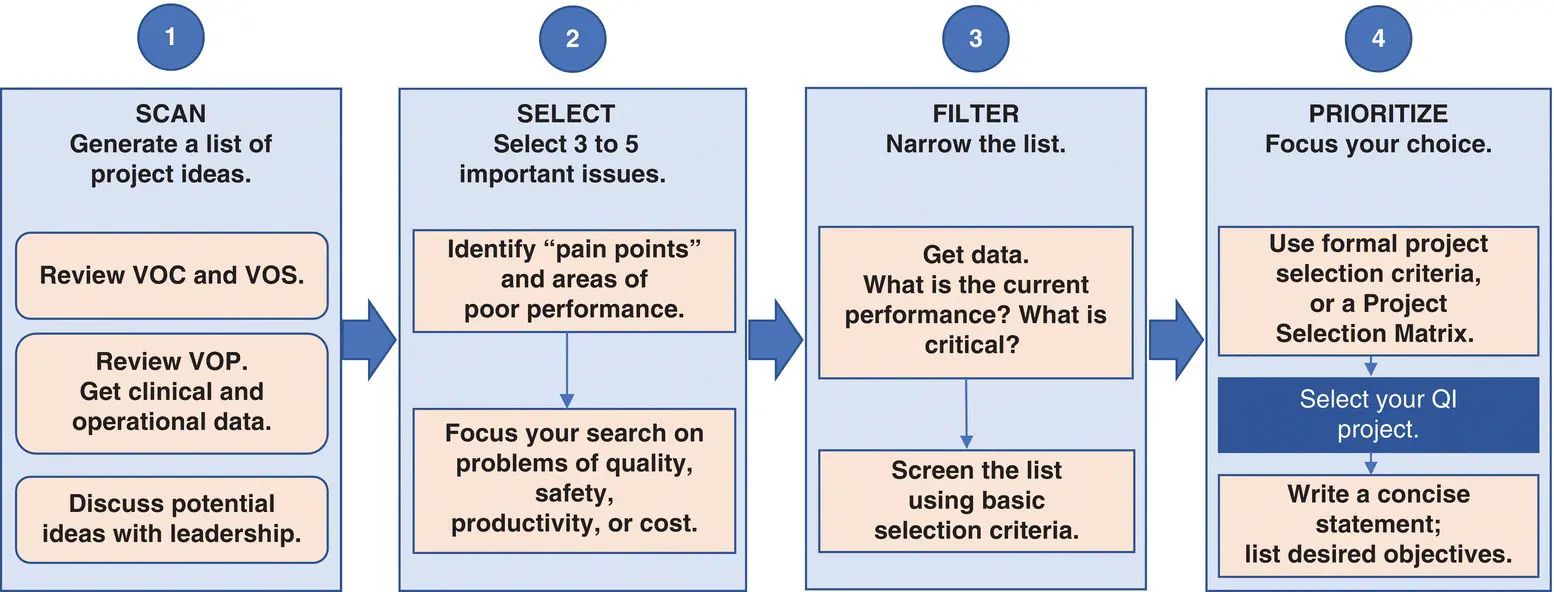Criteria for prioritizing potential projects has been operationally defined and accepted by key leaders.
Projects are selected based on their relationship to the hospital’s (area, unit, department) strategic initiatives and goals.
Leadership actively supports selected projects and is willing to provide the necessary resources.
Successful projects are those that are important to you and at the same time have the support of the leaders. Spend time during the project selection process to make sure you screen project ideas, focus your approach, and select the project that best delivers on the needs of your organization. If your project is not addressing the most pressing issues, you may not generate the support and get the resources you need. When that is the case, leadership buy‐in may be difficult, mid‐level manager’s resistance may be high, and your team will struggle. The eventual outcome of your QI efforts may be less than ideal.
Project Selection Criteria
For each problem you have identified, define the current state of performance and compare it to the ideal state of performance. Do you have data you can use? What is the gap between the current state and ideal state of performance? How will we know we need to improve if we don’t have data? What issues are critical? Narrow down the list of projects to those that address critical issues or are directly related to them. For each project, write a summary statement that details the current state versus ideal state and the gap between them. Define your project’s desired outcomes.
Consider the scope and complexity of the improvement effort. What resources are available? Choose wisely! Consider your availability as well as the availability of project leaders, team leaders, and team members, especially if their involvement in the project is not part of their primary role. Remember, you still have a full‐time job!
Several criteria are important to consider when selecting your project:
The Aim/ Purpose. Every QI project must be related back to the overall strategic initiatives and goals of the organization (department, unit) via the metrics of the project. Project metrics such as safety, quality, productivity, or costs must be traceable both up and down throughout the organization. What is the gap between the ideal state and current state of the process performance? How do you know? Is the project targeting the internal or the external customer?
Scope. What work process will be the focus of your QI project? What will be the start point and what will be the end point? What performance gap are you trying to close? Is your project overly ambitious for the time allowed? Make sure the scope of your project is realistic and you are not trying to take on too much, often referred to as “trying to boil the ocean.”
Leadership. Make sure senior and local leadership can actively engage in supporting the project and are willing and able to provide the necessary resources (time, personnel, administrative assistance, money). Remember, one of the most important resources is time! Time away from clinical duty is needed to actually be able to successfully complete and implement the QI project.
Timeline. Can the project realistically be completed within a one‐ to six‐month period? A good rule of thumb is for the first couple of projects to set the target to one to three months. If the project duration extends longer than six months, other issues may arise that will make it difficult to complete your project.
Competing priorities. Will any other initiatives be affecting the process targeted for improvement?
What Does a Good Project Idea Look Like?
There are several characteristics of a good project, including the following:
The project is connected to the hospital’s (area, unit, department) strategic objectives and addresses the current priorities of leadership.
The problem addressed by the project is recognized to be of major importance and addresses issues of quality, safety, productivity, or cost.
There is a clear primary metric that the project is trying to improve.
The project scope and boundaries are not too ambitious, and the project timeline is acceptable.
The project will have support from senior and local leadership.
Project selection follows these four steps (see Figure 3‐2):
1 Scan. Generate a list of project ideas. Review the VOC, VOS, and VOP if available. Review your clinical and operational metrics. Discuss ideas with leadership.
2 Select. Select 3 to 5 important issues. Identify your frontline staff’s “pain points” and areas of poor performance based on available information and data. Using the above information, develop a list of potential projects; add any other ideas you may have. Focus on problems of quality, safety, productivity, or cost.
3 Filter. Narrow the list. Get data (if available). What is the current performance? What is critical? What needs to be addressed? Screen your list with basic criteria outlined in the previous section. Sort any of those that do not meet the necessary criteria. Write a concise statement listing desired objectives.
4 Prioritize. Focus your choice. Evaluate and prioritize the remaining potential projects. Use the Project Selection Criteria or a Project Selection Matrix; Once you have selected a project, plan how you are going to get the necessary support and resources. Write a brief summary of the problem to validate the potential project.

FIGURE 3‐2Project selection steps.
Be careful not to “bite off more than you can chew.” It is generally better to do two or three projects really well rather than to focus on the total number of projects completed. The goal of a QI initiative is not to do projects but to improve processes. Be patient – worthwhile QI projects take time to properly complete.
Once you have selected your QI project, you should have the following:
A defined and agreed on aim/purpose that is related up and down the organization via metrics;
A focused problem statement that is clear and easy to understand, and that accurately describes the gap in performance;
A competent team leader and team members who want and have the motivation to improve; and
An engaged leader with the authority and willingness to support the QI initiative.
See these requirements in the next chapters.
THE PROJECT SELECTION MATRIX: A TOOL TO PRIORITIZE QI PROJECTS
The Project Selection Matrix is a tool that combines project selection criteria with weighted scores used to prioritize the most relevant projects.
In this example we use a Project Selection Matrix to compare two projects. The Project Selection Matrix uses four columns to assess each project:
1 Column A: Project Criteria. List general project selection criteria that are important for your projects and organization.
2 Column B: Priority Score. List the numeric values assigned to each criterion. These values are assigned by senior leadership, mid‐level leaders, or the QI team to highlight the most relevant requirements for the projects. Use a scale from 1 to 10, with 1 being assigned to the criterion you have decided is least importance and 10 to the criterion with the highest relevance.
3 Column C: Correlation Score. Evaluate the correlation of each project against each of the criterion. Use a scale of 1 to 10, where 1 has the weakest match with the proposed criterion and 10 is assigned to the criterion that best matches the project characteristics. Starting out, it may be easier to use a simpler and cleaner approach, using a scale of 0, 3, 5, and 9 so that it is easier to discern between projects with 0 = no relationship, 3 = weak relationship, 5 = moderate relationship, 9 = strong relationship.
Читать дальше













